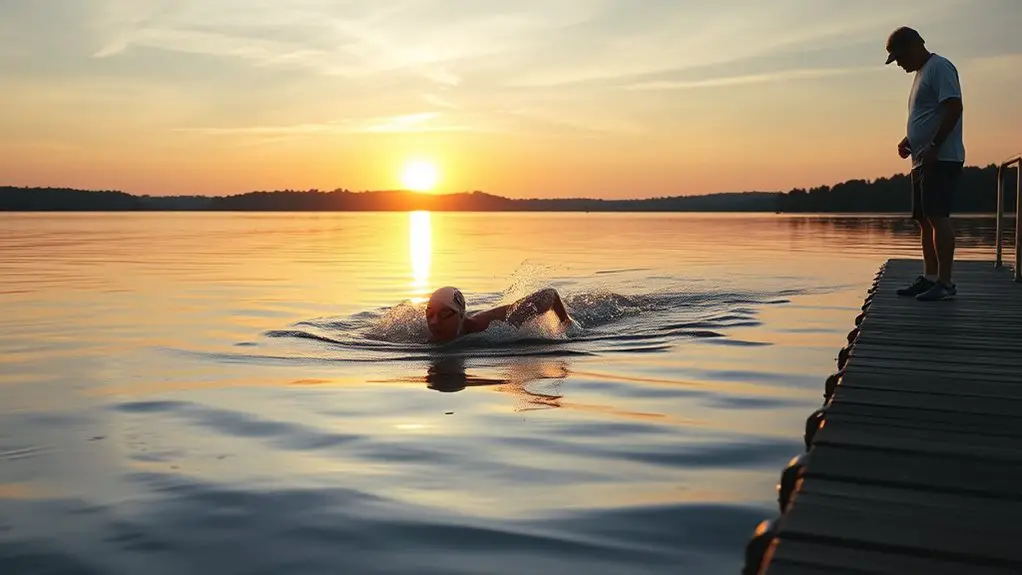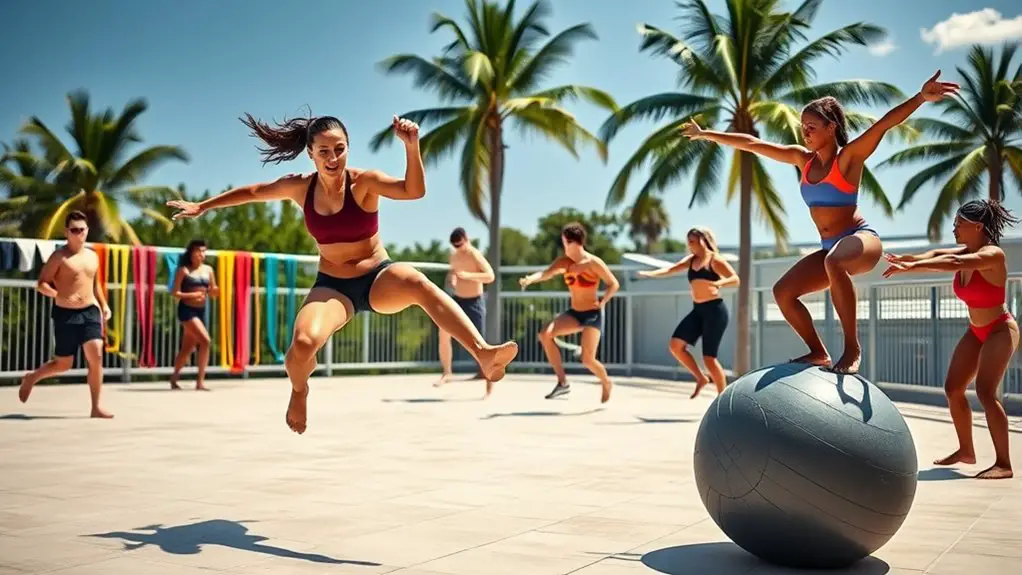To build endurance in long-distance swimming, focus on mastering your technique, like body position and breath control. Set realistic goals and follow a consistent training plan that includes 3-5 swim sessions per week. Incorporate cross-training and interval workouts to boost stamina and aerobic capacity. Don't forget proper nutrition and hydration to fuel your body, plus rest days for recovery. With these strategies, you'll improve your performance and achieve your swimming goals—there's more to discover next!
Understanding Endurance in Swimming
Endurance in swimming is an essential component that separates casual swimmers from serious competitors. It's not just about how fast you can swim; it's about how long you can keep going without losing steam. When you build endurance, you're not just enhancing your physical capabilities; you're revealing a sense of freedom in the water. You'll feel empowered, able to conquer longer distances and explore new horizons.
To develop your endurance, focus on gradually increasing your distance and time in the water. Incorporate longer training sessions and mixed-pace drills to build stamina without feeling monotonous. Listen to your body; recognize when to push and when to rest. Every stroke should be purposeful, allowing you to flow through the water effortlessly. When you embrace endurance training, you set yourself free to swim longer and enjoy the vastness of open water, making each swim a liberating adventure. Additionally, consistent mileage builds aerobic capacity, which can significantly aid in your endurance progress.
The Importance of Technique
When it comes to long-distance swimming, mastering your technique is essential for success. Focusing on stroke efficiency and breathing technique can make a significant difference in your endurance and speed. By refining these skills, you'll swim longer with less effort. Additionally, enhancing shoulder strength is crucial for maintaining effective movement throughout your swim.
Stroke Efficiency
While many swimmers focus on building stamina, neglecting stroke efficiency can hinder your long-distance performance. A smooth, efficient stroke allows you to glide through the water with less effort, conserving your energy for those longer swims.
| Key Elements | Tips for Improvement |
|---|---|
| Body Position | Keep your body flat and streamlined. |
| Arm Movement | Extend fully and enter the water gently. |
| Kick | Use a steady, rhythmic flutter kick. |
| Hand Entry | Enter the water with fingertips first. |
Breathing Technique
Breathing technique plays an essential role in your long-distance swimming performance, as proper breath control can considerably affect your stamina and efficiency. Mastering your breathing not only keeps you relaxed but also enhances your overall technique. Here are a few key points to take into account:
- Breathe deeply: Fill your lungs fully to maximize oxygen intake and reduce fatigue.
- Timing is vital: Coordinate your breaths with your strokes to maintain a smooth rhythm.
- Practice exhaling: Focus on exhaling underwater, which prepares you for quicker inhalation when you surface.
Setting Realistic Goals
Setting realistic goals is essential for your success in long-distance swimming, as it keeps you motivated and focused on your progress. Start by evaluating your current skill level and endurance. Rather than aiming to swim a marathon right away, break it down into manageable milestones. Maybe it's completing a 500-meter swim without stopping or mastering a new stroke. These smaller targets will boost your confidence and reinforce your commitment.
Don't forget to celebrate your achievements, no matter how small. Each step forward is a victory that fuels your passion for swimming. Be flexible in adjusting your goals as you progress, allowing for setbacks or unexpected challenges. Remember, the journey is just as important as the destination, so embrace the freedom that comes with setting achievable objectives. Ultimately, it's about enjoying the water and discovering what your body can truly accomplish over time. Additionally, understanding your current fitness levels can help tailor your training and ensure steady progress.
Developing a Training Plan
When it comes to developing your training plan, establishing a consistent workout frequency is key to building endurance. You'll want to monitor your progress regularly to adjust your plan as needed. This approach will help guarantee you stay on track and reach your long-distance swimming goals. Additionally, incorporating proper hydration strategies during your training sessions can significantly enhance your endurance performance.
Establishing Workout Frequency
Consistency is key in establishing a workout frequency for long-distance swimming. You'll want to find a balance that fits your lifestyle while pushing your limits. Here are some tips to help you create your ideal frequency:
- Aim for 3-5 swim sessions per week: This range helps build endurance without overwhelming your body.
- Mix in cross-training: Incorporate activities like running or cycling to maintain overall fitness and avoid burnout.
- Listen to your body: If you're feeling fatigued, don't hesitate to adjust your schedule. Recovery is essential for progress.
Monitoring Progress Regularly
To effectively develop your training plan, it is crucial to monitor your progress regularly. Tracking your swimming distances, times, and techniques can help you pinpoint what works and what needs improvement. Consider using a swim log or an app to keep it simple and organized. Each week, reflect on your sessions—celebrate small victories and identify challenges. Adjust your training as needed, whether that means increasing your distance or refining your stroke. Remember, it's all about finding your rhythm and staying motivated. As you monitor your progress, you'll not only gain insights into your endurance but also stay connected to your goals. Embrace the freedom that comes with understanding your journey and watch how it transforms your performance.
The Role of Nutrition
Although many swimmers focus on their technique and training regimen, nutrition plays an essential role in enhancing endurance for long-distance events. Fueling your body properly can make a significant difference in your performance. Here are some key nutritional aspects to reflect on:
- Hydration: Staying hydrated is vital; even mild dehydration can impact your stamina. Ensuring that you monitor urine color can help you assess your hydration status effectively.
- Carbohydrates: They're your primary source of energy. Incorporate whole grains, fruits, and vegetables to keep your glycogen stores full.
- Protein: Essential for muscle repair and recovery. Include lean proteins like chicken, fish, or legumes after workouts.
Cross-Training for Improved Performance
Incorporating cross-training into your routine can considerably enhance your long-distance swimming performance. By mixing in different activities, you can build strength, flexibility, and endurance while giving your swimming muscles a break. Think cycling, running, or even yoga—each offers unique benefits that translate into the pool.
Cycling boosts your cardiovascular fitness without the impact stress on your joints. Running helps develop your leg muscles and overall stamina, while yoga enhances your flexibility and breathing techniques. These activities not only improve your physical condition but also keep your training fresh and exciting. Additionally, engaging in cross-training can lead to enhanced cardiovascular endurance, which is crucial for long-distance swimming.
Try scheduling these sessions a few times a week, ensuring they complement your swim workouts. You'll find that your body becomes more resilient, and your swimming efficiency improves. So, embrace the freedom to explore various exercises; it's a powerful way to elevate your performance and enjoy your training journey even more!
Mental Strategies for Long-Distance Swimming
Here are some mental strategies to reflect on:
- Visualization: Picture yourself swimming smoothly and efficiently. Imagine the feeling of gliding through the water, creating a strong mental connection to your goals.
- Positive Self-Talk: Replace negative thoughts with affirmations. Remind yourself of your strength and determination; it'll help you push through tough moments.
- Mindfulness: Stay present in the moment. Focus on your breath, strokes, and the rhythm of your body in the water. This can help reduce anxiety and enhance your experience. Additionally, incorporating positive affirmations into your routine can significantly boost your confidence and mental resilience during challenging swims.
Incorporating Interval Training
Interval training can greatly boost your endurance and speed in long-distance swimming. By incorporating structured bursts of intensity into your workouts, you'll not only enhance your performance but also keep your training sessions engaging. Let's explore the benefits of interval training and some sample workouts you can try. Additionally, this method allows you to discover true potential as you push your limits and embrace the rhythm of intensity and recovery.
Benefits of Interval Training
When you integrate interval training into your long-distance swimming routine, you'll discover a host of benefits that can greatly enhance your endurance. This approach not only boosts your stamina but also empowers you to swim longer and stronger with a sense of freedom. Here are some key advantages:
- Improved Aerobic Capacity: You'll increase your lung capacity and efficiency, allowing for longer swims without fatigue.
- Enhanced Speed: Short bursts of high-intensity effort help you develop speed, making those long distances feel more manageable.
- Mental Toughness: Pushing through intervals builds resilience, giving you the confidence to tackle challenging swims with ease.
Embracing interval training can transform your swimming experience, taking you closer to your endurance goals.
Sample Interval Workouts
To effectively build your endurance, incorporating targeted interval workouts into your training routine can make all the difference. Start with 10 x 100 meters at a fast pace, resting for 20 seconds between each. This helps simulate race conditions while pushing your limits. Next, try 5 x 200 meters, focusing on maintaining a steady speed, with 30-second rests. For a challenge, include 4 x 400 meters at a strong pace, resting for 45 seconds. Don't forget to mix in some longer sets, like 3 x 800 meters, swimming at a moderate pace to build stamina. Remember, consistency is key. Listen to your body, and adjust rest times as needed. Enjoy the freedom of the water while you train!
Recovery and Injury Prevention
Although pushing your limits is essential for improving endurance in long-distance swimming, effective recovery and injury prevention are just as important. If you want to swim freely and enjoyably, you need to take care of your body. Here are some key tips to help you recover and stay injury-free:
- Hydrate and refuel: After long swims, drink plenty of water and eat a balanced meal to restore energy levels and muscle function.
- Incorporate rest days: Giving your body time to recover is crucial. Schedule rest days to allow muscles to heal and strengthen.
- Listen to your body: Pay attention to signs of fatigue or pain. If something feels off, don't hesitate to adjust your training or seek professional advice. Remember that proper nutrition strategies can significantly enhance your recovery process.
Tracking Progress and Adjusting Training
How can you effectively track your progress and adjust your training for long-distance swimming? Start by logging your swim distances, times, and how you felt after each session. Use a swim watch or app to help you keep an accurate record. This data lets you see improvements over time, helping you set achievable goals.
Next, listen to your body. If you're feeling fatigued or struggling to meet your targets, it might be time to modify your training plan. You want to maintain that freedom in your routine, so don't hesitate to mix things up—try different techniques or vary your workout lengths.
Lastly, consider joining a swim group or finding a coach. Sharing experiences can provide insights and motivation. By tracking your progress and being flexible with your training, you'll build the endurance you need while enjoying the journey of long-distance swimming.
Frequently Asked Questions
What Swimming Strokes Are Best for Building Endurance?
When you're looking to build endurance, freestyle and backstroke are your best bets. They keep your body streamlined and allow for longer sessions without excessive fatigue. Mix in some breaststroke for variety and muscle engagement!
How Often Should I Swim Each Week for Endurance?
To boost your endurance, aim to swim at least three to five times a week. Consistency's key, so find a schedule that fits your life, allowing you to enjoy the freedom of the water.
What Gear Do I Need for Long-Distance Swimming?
When diving into the vast ocean of long-distance swimming, you'll need a reliable swimsuit, goggles, a swim cap, and perhaps a wetsuit for colder waters. Don't forget a hydration system to keep your spirit flowing!
Can I Train for Endurance in a Pool Instead of Open Water?
Absolutely, you can train for endurance in a pool! While it's different from open water, focusing on interval workouts and longer swims will still build your stamina. Just make sure to mix things up for variety!
How Do Weather Conditions Affect Long-Distance Swimming Training?
You might not realize it, but weather can make or break your training. Wind, temperature, and waves can challenge you, pushing your limits. Embrace the elements, and you'll discover newfound strength and resilience in your swimming journey.




